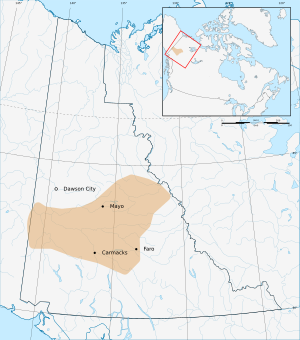Northern Tutchone facts for kids
| Dän k'í | |
|---|---|
| Regions with significant populations | |
| Canada (Yukon) | |
| Languages | |
| Tutchone language | |
| Religion | |
| Christianity, Animism | |
| Related ethnic groups | |
| Southern Tutchone |
The Northern Tutchone are an Indigenous group of people in Canada. They are part of the First Nations and live mostly in the central Yukon territory. Their traditional language is part of the larger Athabaskan language family.
Who are the Northern Tutchone?
The Northern Tutchone people have lived in the central part of the Yukon for a very long time. They are known for their rich culture and deep connection to the land. Their way of life traditionally involved hunting, fishing, and gathering. They have a strong history of living in harmony with nature.
The Northern Tutchone Language
The Northern Tutchone language is a special part of their heritage. It is a unique way of speaking that belongs to the Athabaskan language family. This family of languages is spoken by many Indigenous groups across North America.
Sadly, fewer people speak the Northern Tutchone language today. But there are efforts to keep it alive. For example, a musician named Jerry Alfred is working to preserve the language. He uses his music to share the language with new generations. This helps ensure that the language continues to be heard and learned.
Northern Tutchone Governments
The Northern Tutchone people have their own governments. These governments work to support their communities and preserve their culture. Here are some of the main Northern Tutchone First Nations and their communities:
- First Nation of Na-Cho Nyäk Dun (in Mayo, Yukon)
- Their name means "Big River People." They called the Stewart River Na Cho Nyak, which means Big River. This is the most northern Northern Tutchone First Nation.
- Little Salmon/Carmacks First Nation (in Carmacks, Yukon)
- Their name is Tagé Cho Hudän, which also means "Big River People."
- Selkirk First Nation (in Pelly Crossing, Yukon)
- Their name is Hućha Hudän, meaning "Flatland People." This name comes from the flat land around Fort Selkirk, where the land is flat on both sides of the river.
These First Nations governments play an important role in their communities. They help manage resources, protect traditional lands, and promote their culture and language.


